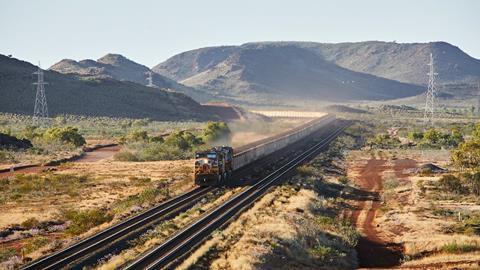
AUSTRALIA: A 166 km branch has been built to connect Rio Tinto’s new Gudai-Darri iron ore mine in the Pilbara to its 1 700 km heavy haul network, which is operated using AutoHaul driverless trains.
The first loaded train ran in June, with production scheduled to ramp up to reach full capacity during 2023.
Rio Tinto’s 17th and ‘most technologically advanced’ iron ore mine in the Pilbara was developed at a capital cost of A$4·3bn. It has an expected life of more than 40 years and an annual capacity of 43 million tonnes.
As well as being served by the driverless trains, the new mine features autonomous haul trucks and water trucks, robotics for the ore sampling laboratory and distribution of parts in the workshop, and a 34 MW photovoltaic solar farm. The autonomous equipment is monitored from Rio Tinto’s Operations Centre in Perth, 1 500 km away.
Hitachi Rail is the technical lead for AutoHaul, and provided the onboard and control centre technology, trackside equipment, radio base stations and automatic train operation interface software for locomotive control, level crossing safety and location tracking.
Hitachi Rail Australia Senior Director Roslyn Stuart said the project was ‘another first, with back-to-back high performing automated train loading to be introduced on the Gudai-Darri mine rail loop’.
Rio Tinto Iron Ore Chief Executive Simon Trott said ‘Gudai-Darri represents a step-change in the deployment of automation and technology within our iron ore business and a fantastic demonstration of the talent, ingenuity and capability that exists in Western Australia, a region which is now known globally for its technical excellence and innovation. Gudai-Darri’s combination of data and analytics, machine learning and automation, will make this mine safer and more productive.’

















